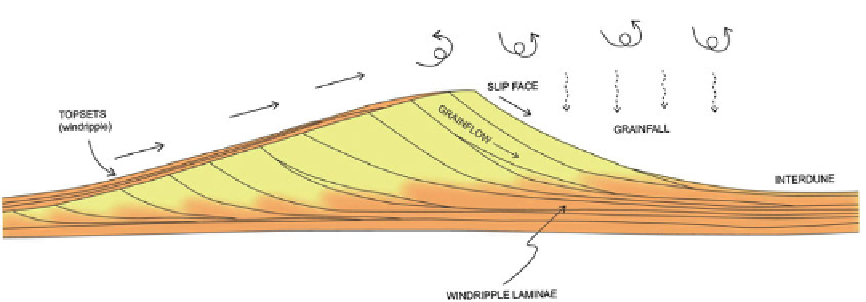Geoscience Reference
In-Depth Information
Fig. 6.1
Typical elements of aeolian systems
systems with blocky responses on open hole logs.
Consequently, there is a tendency to treat them as
'sand tanks', a tendency encouraged by well-
behaved porosity-permeability relationships
derived from the excellent sorting capability of
the wind.
The risk is therefore that aeolian systems can be
over-simplified, particularly because important
heterogeneities are often found at a scale below
log resolution. The highly laminated nature of
aeolian strata and the strong permeability contrasts
between some of these strata are belied by rela-
tively benign standard log responses.
Aeolian systems are, however, very well
organised with distinct generic bedform types,
and thus lend themselves well to modelling, and
multi-scale modelling in particular. The highly
laminated
wind
ripple
laminations,
a product of
saltation, and
adhesion strata, resulting from drifting sands
adhering to damp surfaces.
The aeolian bedding types usually have dune
morphologies and have predictable reservoir
property contrasts (Weber
1987
, Fig.
6.1
). As a
rule of thumb, dune systems offer the best quality
reservoirs, and it is the well-sorted, mostly
coarse-grained grainflow beds on the slip faces
of the dunes which typically carry the highest
permeabilities within the dunes (Heward
1991
).
Figure
˕
relationships for these elements; with grain flow
sands on the slip face offering an order of mag-
nitude uplift in permeability for any given poros-
ity class.
6.2
shows
some
typical
k/
heterogeneity
is
typically well
organised
and
therefore within
reach
of
geologically-based modelling tools.
6.1.2 Effective Properties
The effective properties of some elements of
aeolian systems are captured well by standard
log and core measurements; however, for other
elements, especially the different lamina types,
this is predictably not the case, and a consider-
ation of the multi-scale REVs for aeolian systems
distinguishes the elements which require more
attention. The excellent exposure of the dune
system shown in Fig.
6.3
reveals many
heterogeneities, which can be summarised in
terms of permeability length scales and a hierar-
chical arrangement of REVs, as
6.1.1 Elements
The component model elements of aeolian
systems are well understood. Fryberger (
1990a
)
describes aeolian systems in terms of four main
facies: dune, interdune, sandsheet and sabkha,
within which four principal types of bedding
recur:
grainflow strata, resulting from avalanche
down the steep side of dunes,
grainfall
strata,
dropped
from airborne
shown in
transport,
Fig.
6.4
.

